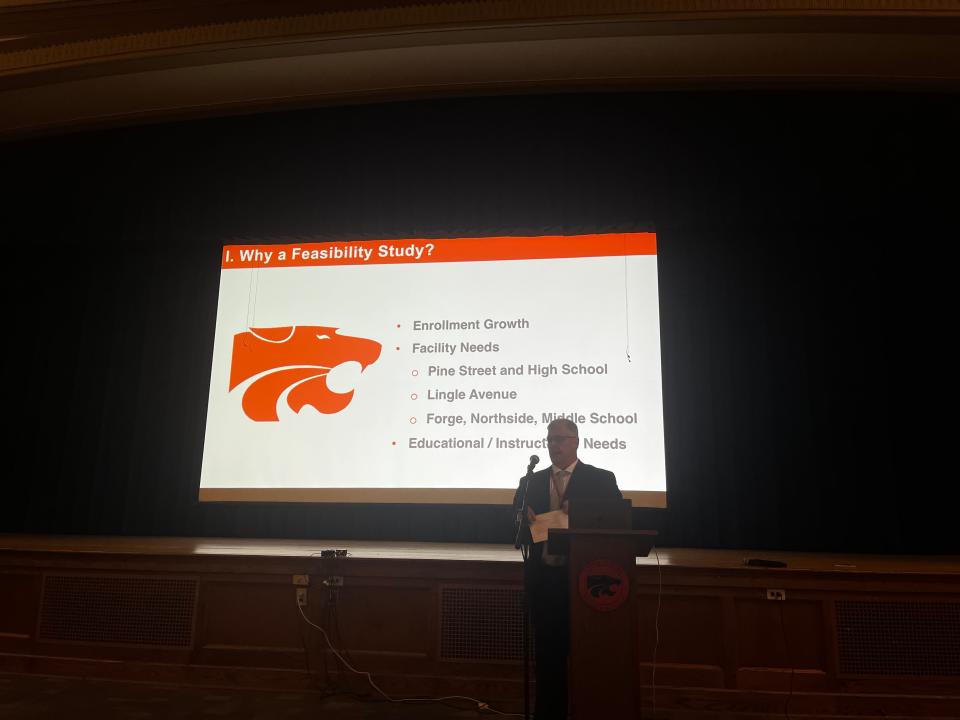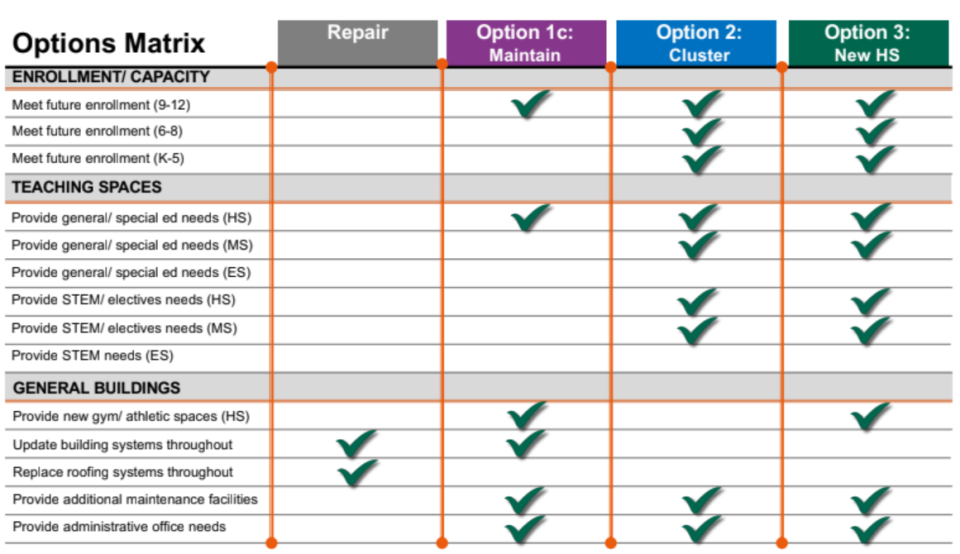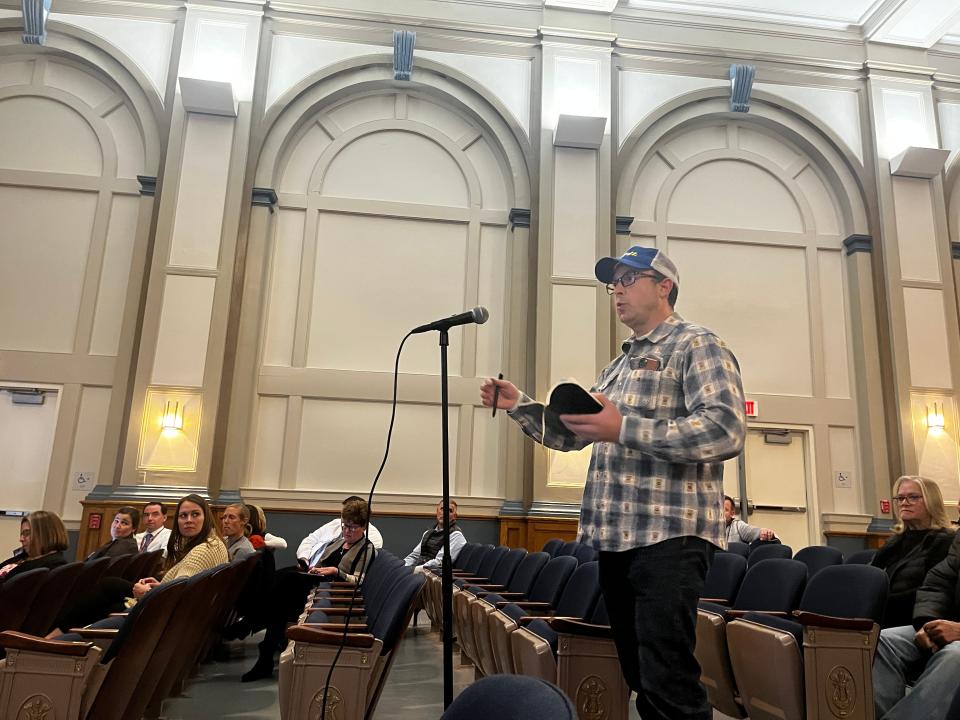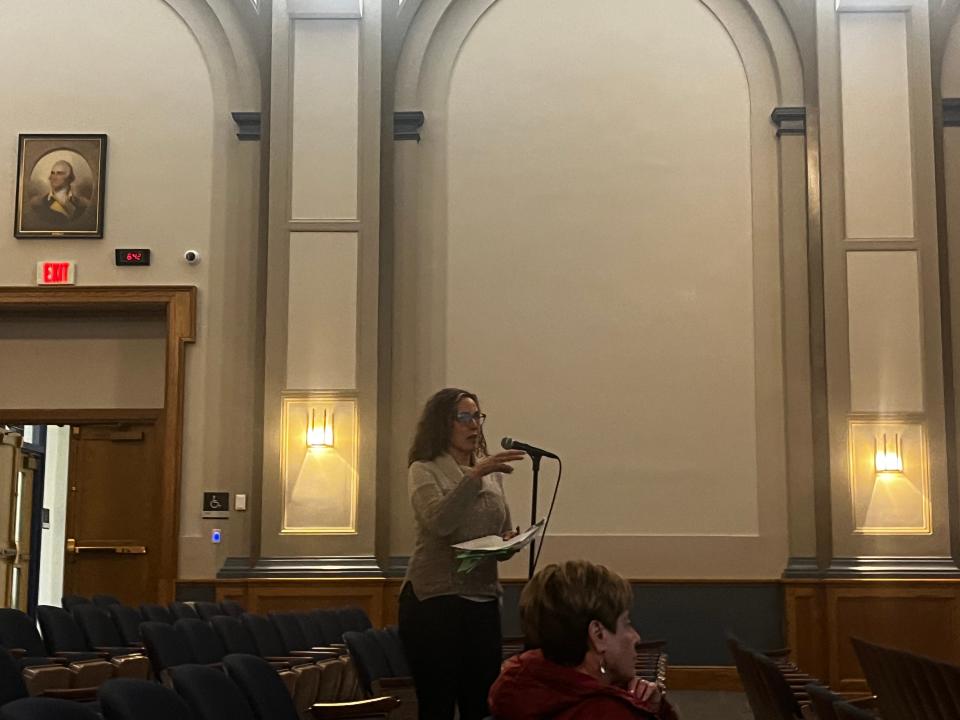Build? Renovate? Public hears options for Palmyra Area School District facilities' futures
Palmyra Area School District administration and representatives from Lancaster-based architecture firm RLPS gave a presentation Tuesday night on a feasibility study that looks to address the future needs of the district during a public forum held at the middle school auditorium.
The three issues the study looks to address are overcrowding, maintenance needs and instructional needs.
Superintendent Bernie Kepler stressed that it could be months or even years before a decision on the feasibility study is made and that, from a financial perspective, the earliest the district would be able to break ground would be 2027.
The project would be paid for through bond issue.

The district's next steps are continued discussion at the school board committee meetings, which would likely take place in January.
In a survey of district facilities, RLPS found the high school and the middle school offer fewer square feet per student than the average school. The high school, last renovated in 2006, was in the most need. While the middle school had been renovated more recently, the building could not be expanded due to nearby land development and stormwater issue.
According to the study, the average for a high school is 200 square feet per student. Palmyra Area High School has 147 square foot per student. The average for middle schools is 150 square feet per student, while Palmyra middle school has 122 square feet per student.
The elementary schools offer closer square footage per student compared to the average and are largely in good shape. However, additional space for special education classrooms and separate spaces for gyms and cafeterias are needed at some facilitates. Northside and Forge Road elementaries were recently updated, while Pine Street hasn't been renovated since 2004 and will likely need systems upgrades in the near future.

What are Palmyra's options in the study?
The feasibility study in its current form offers four options:
Maintaining and repairing the district's facilities for an estimated cost between $62.87 million and $72.85 million. This is the least expensive option and would bring facilities up to standard. It would not address educational or capacity issues.
Maintaining grades, a step-up option, would provide additions, renovations and repairs to the high school building, Buck Swank Stadium improvements and turf on the high school softball field at the minimum. It could provide maintenance and repairs to Northside, Pine Street and Forge Road elementary schools depending on what sub-option were selected. It could cost between $97.21 million and $161.21 million.
Clustering grades would provide additions and renovations to the high school; additions and renovations to Northside, which would then be used for grades 4-6; and make Lingle Avenue a kindergarten and first-grade school, Pine Street a second- and third-grade school and have Forge Road Elementary no longer be used for education, potentially becoming the district office. This option would cost between $144.52 million and $177.95 million.
Building a new high school would lead the middle school hold grades 6-8 and turn the existing high school into an intermediate school for grades 4-5. Lingle Avenue and Pine Street elementary schools would be used for kindergarten through third-grade students, while Northside and Forge Road elementary schools would no longer be used for education. This option would cost between $156.78 million and $179.59 million.
Building a new high school would grant the district the most flexibility in terms of enrollment but would not address the need for building and roofing systems across facilities. Those projects would likely have to be completed through the general operating budget as a smaller capital project for the school.
None of these options arise locked in. They can be reworked as the district moves forward.
What does the public say about the feasibility study?
Former Palmyra School Board member Ralph Duquette was the first person to speak during the Q&A portion of the forum. He pointed out that the district could potentially raise taxes above the Act 1 index, which is the percent set by the state each year by which school districts are able to raise taxes, through a referendum.
He also wished to see more specifics on the reconstruction, renovations and mechanical changes that the facilities need, why Lingle Elementary was considered an aging building, as well as more specifics on previous renovations including how they were financed and existing debt load for each building.
"The district's budget is roughly $60 million," he said. "So when you start talking about a $180 million project, you know, people get really concerned. That's three times the budget. "
Kepler went through some of the soft renovation projects between 2016 and 2019 including the middle school project which widened hallways, added spaces to the cafeteria and added a sixth-grade wing, which was at capacity when it opened. Paint, finishes, flooring and mechanical systems renovations were done at Forge and Northside elementary as Guaranteed Energy Savings Act projects.
"One of the key things," Kepler said, "this is so early, that we are not poised to go into much more detail. Our intent is that that's going to take time to decipher, where do we want to go? The purpose for RLPS bringing us proposals that have cost ranges is looking at low costs of construction, looking at high."
He also said the district pays roughly $6 million, or 10% of the budget annually on its debt.
Resident Jack DeCicco asked how much of that payment is principal versus interest.

Director of business affairs for the district Mike Frentz said $4 million to $5 million of those payments each year are principal.
Kepler added that as it stands the district would be completely debt free by 2032.
Kepler listed several housing developments and apartments that are under construction around the district, illustrating how an increase in housing around the area could contribute to increased students in the schools, and why they should be talking about this now rather than later.
Jill Martin questioned those projected enrollment figures.
"I have spent the last couple of weeks, looking at whatever data I could find for that expected growth beyond just saying there's these developments coming and what we think is happening. So there is a 461-page 2023 housing assessment from Lebanon County. I also read the 183-page feasibility study you did in 2015. I have copies of all the subdivision plans that been filed since 2015 when the last feasibility study was done, I read through all of those."

Martin said she did not see the same projected growth in her research that the district was seeing, saying she only sees growth of .3% in the Palmyra district, with most of that growth being in the senior age groups. She also said she sees the number of students in the district decreasing in the next few years.
"I think perhaps we've fallen into the trap that you think past population growth is going to start again and then continue, but the data really suggests completely opposite."
Martin believes spending the money toward maintenance might be a better choice over building for space that the district might not need five years down the road.
Kepler said that while those reports, along with the enrollment study the district commissioned roughly three years ago, show stable enrollment for the next 5-10 years, the district is already over capacity.
"For example, we have, in 2025-26, we have to be looking to open a new special needs classroom in our high school, (and in) 26-27, a second one. We don't have classrooms right now for those classrooms. So, they are going need classrooms, other teachers will be on a cart moving throughout the day teaching through different rooms, needing that space. We just did the same at the middle school."
He also said that part of this process is defining what space the district needs and where they need it.
"What I'm hopeful to have is, start this conversation with our community now, so we can make that educated decision along the way. What I don't want to have happen is us be behind the 8-ball in 2030 and have portable classrooms throughout our campuses."
Resident Kevin Imes said if the district chooses to pursue one of these options, he hopes they're looking five to 10 years past the doors opening.
"If you're going to spend, let's say $100 million, $110 million to $120 over the bond period is negligible dollars at that point in time. Go for the gold, you know, do the right thing and get the numbers in there."
Daniel Larlham Jr. is a reporter for the Lebanon Daily News. Reach him at DLarlham@LDNews.com or on X @djlarlham.
This article originally appeared on Lebanon Daily News: Palmyra Area School District hears public comment on feasibility study

